AUDI TT COUPE 2017 Workshop Manual
Manufacturer: AUDI, Model Year: 2017, Model line: TT COUPE, Model: AUDI TT COUPE 2017Pages: 322, PDF Size: 79.73 MB
Page 51 of 322
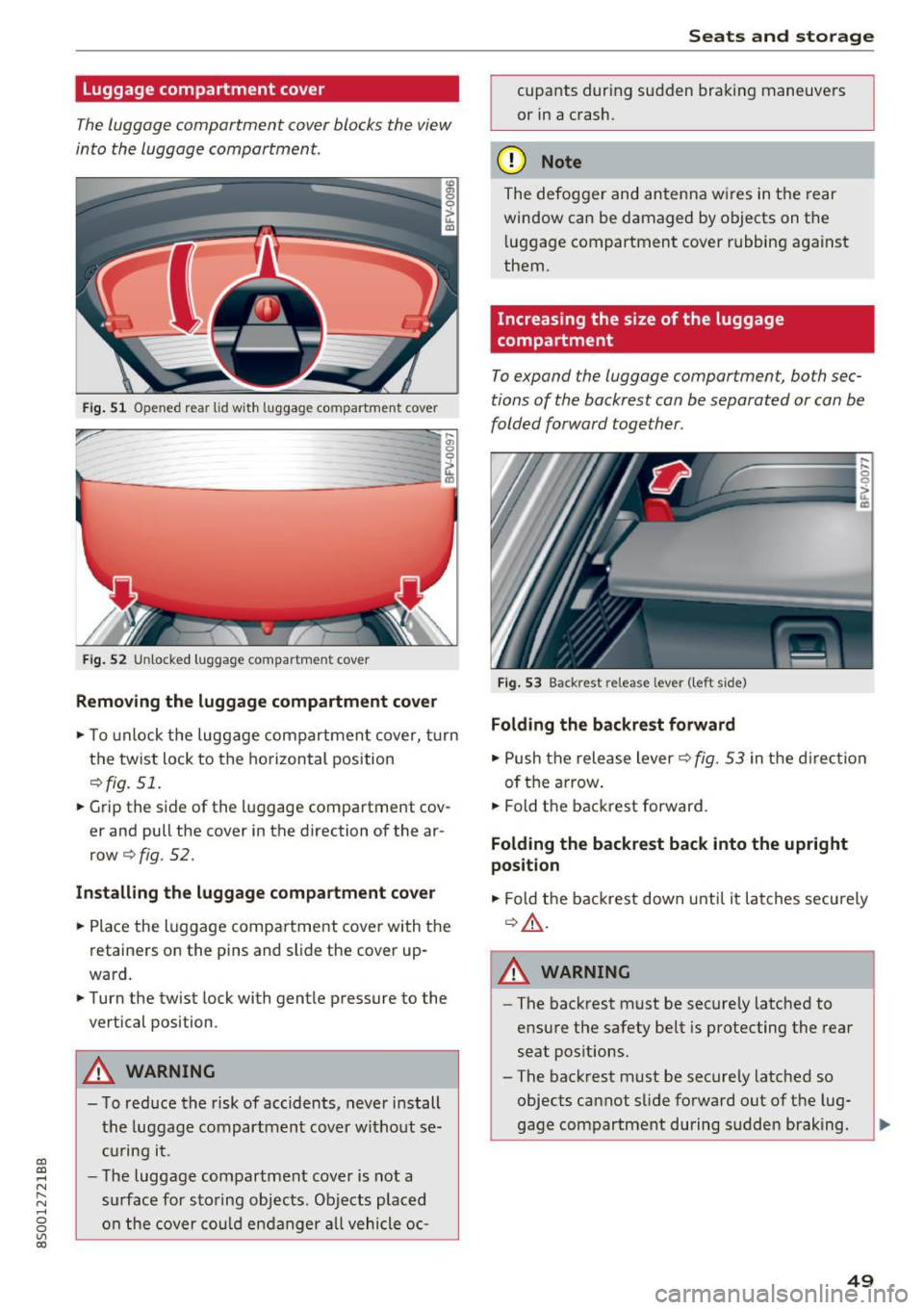
CD co .... N
" N ...... 0
0
Ill co
Luggage compartment cover
The luggage compartment cover blocks the view
into the luggage compa rtment.
Fi g. 51 Opened rear lid wit h luggage compartment cover
... gi 0
~
ir----- ----------- ------CD
Fig. 52 Unlocked luggage compartment cover
Removing the luggag e compartment cover
.,. To unlock the luggage compartment cover, turn
the twist lock to the horizontal position
¢fig. 51.
.. Grip the s ide of the luggage compartment cov
er and pull the cover in the direction of the ar
row¢
fig. 52.
Install ing the luggage compartment cover
.. Place the luggage compartment cover with the
retainers on the pins and slide the cover up
ward .
.. Turn the twist lock with gentle pressure to the
vertical position.
_&. WARNING
- To red uce the risk of accidents, never install
the luggage compartment cover without se
c ur ing it.
- The luggage compartment cover is not a
surface for s to ring objects. Objects placed
on the cover cou ld en danger a ll vehicle oc-
Seats and storag e
cupants during sudden bra king maneuvers
or in a crash.
(D Note
The defogge r and antenna w ires in t he rear
window can be damaged by objects on t he
l uggage compartment cover rubbing against
them.
Increasing the size of the luggage
compartment
To expand the luggage compartment, both sec
tions of the backrest can be separated or can be
folded forward together .
Fig . 53 Backrest release lever ( left side)
Folding the backrest forward
.. Push the rele ase lever¢ fig. 53 in the d irection
of t he arrow .
.. Fold t he backrest forward .
Folding the backrest back into the upright
position
.,. Fold the backrest down u ntil it la tches secu rely
¢ _&. .
_&. WARNING
-The back rest must be securely latched to
ensure the safety be lt is protecting the rear
seat pos itions.
- The back rest must be securely latched so
objects cannot slide fo rward out of the lug
gage compartment during sudden braking.
49
Page 52 of 322
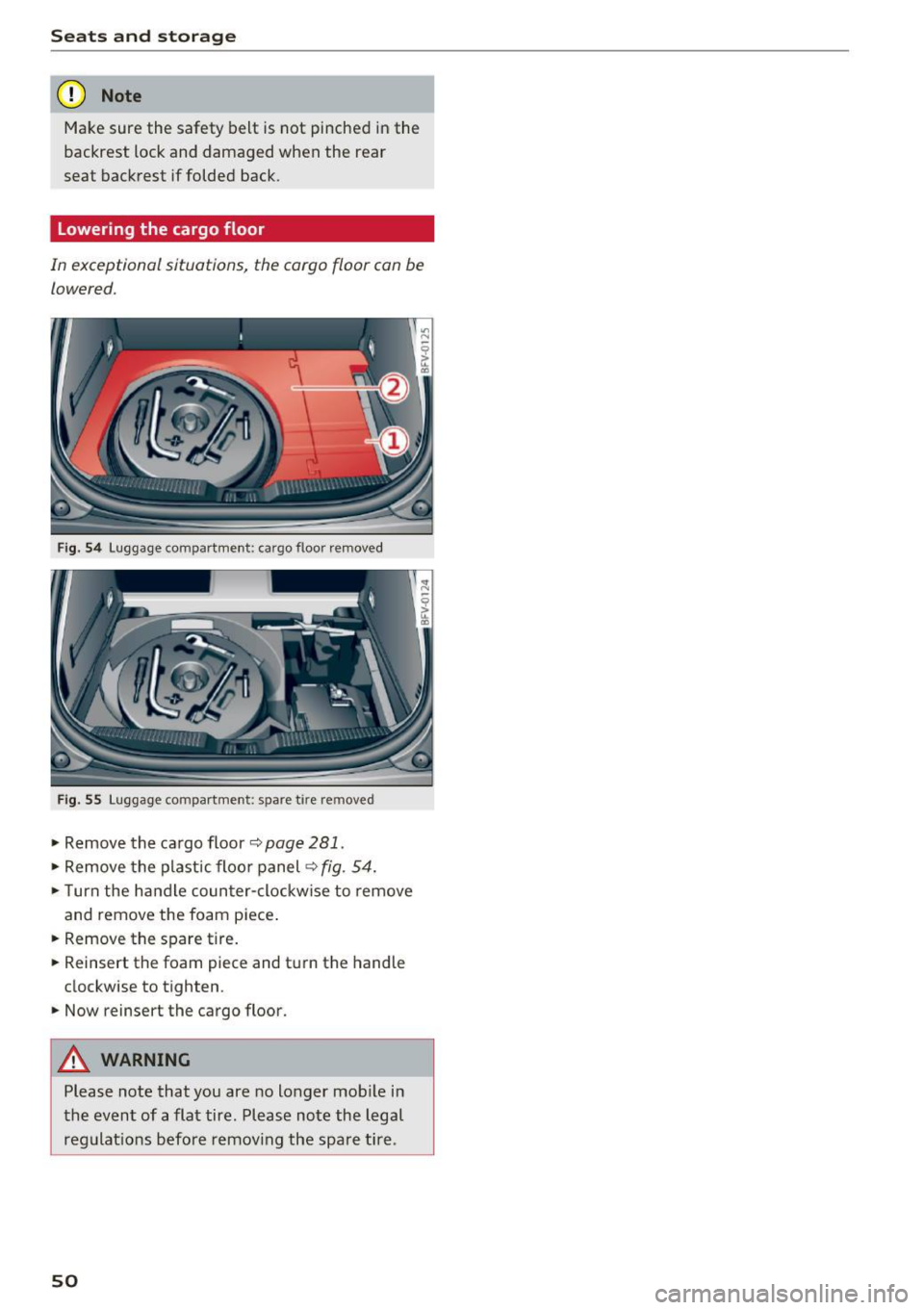
Sea ts and stor age
(D Note
Make sure the safety belt is not pinched in the
backrest lock and damaged when the rear
seat backrest if folded back.
Lowering the cargo floor
In exceptional situations, the cargo floor can be
lowered.
F ig. 54 Luggage compartme nt: cargo floor removed
Fig. 55 Luggage compartment: spare tire removed
• Remove the cargo floor¢ page 281.
• Remove the plastic floo r panel ¢ fig. 54.
• Turn the handle counter-clockwise to remove
and remove the foam piece .
• Remove the spare tire.
• Reinsert the foam piece and tu rn the handle
clockwise to tighten .
.,. Now reinsert the cargo floor.
A WARNING
Please note that you are no longer mob ile in
the event of a flat tire. Please note the legal
regulat ions before remov ing the spare tire .
50
Page 53 of 322
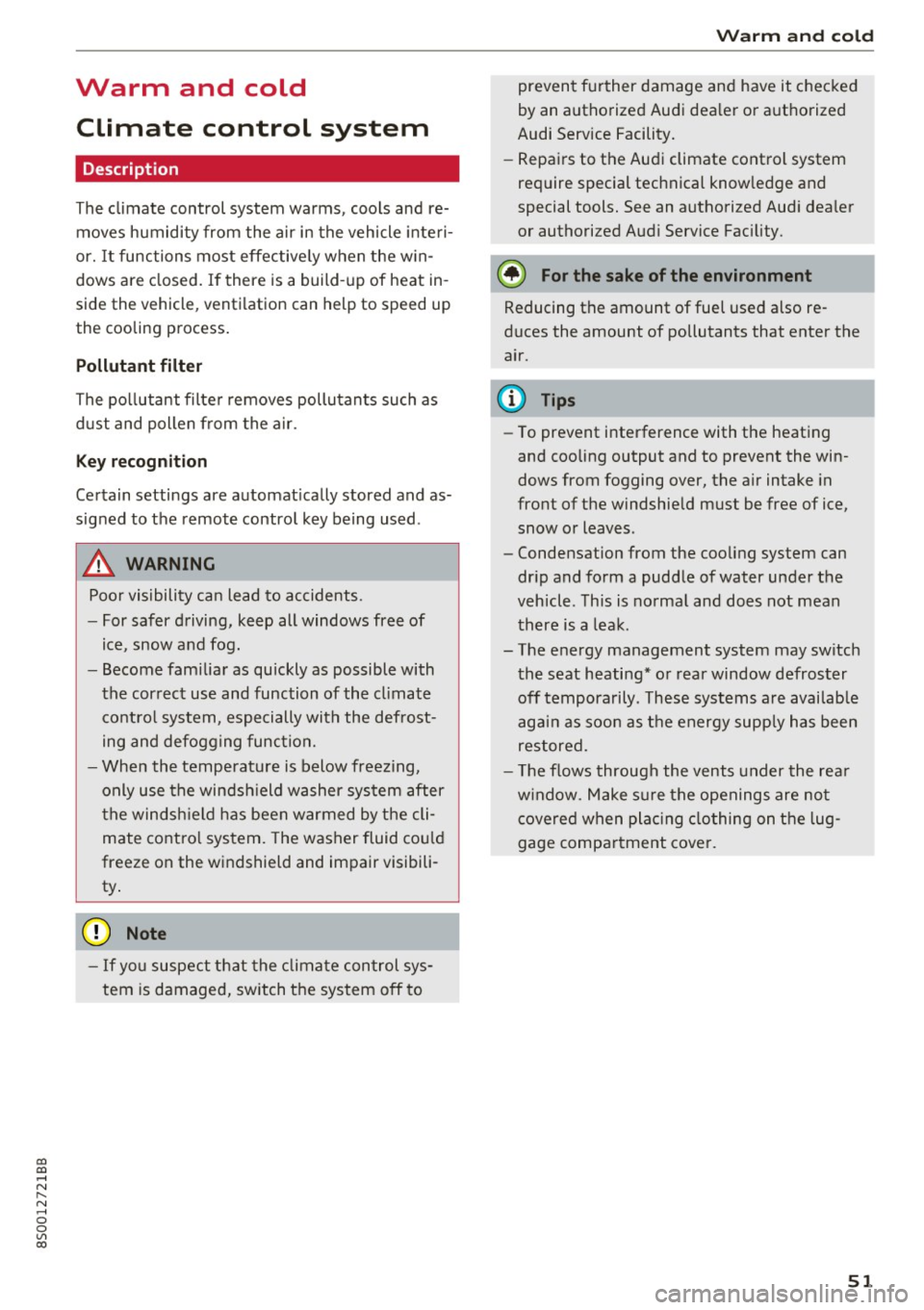
co
co
.... N
" N .... 0
0
Vl c:o
Warm and cold Climate control system
Description
The climate control system warms, cools and re
moves humidity from the air in the vehicle interi
or. It functions most effectively when the w in
dows are closed. If there is a build-up of heat in
side the vehicle, ventilation can help to speed up
the cooling process.
Pollutant filter
The pollutant filter removes pollutants such as
dust and pollen from the air.
Key recognition
Certain settings are automatically stored and as
signed to the remote contro l key being used .
A WARNING
Poor visibility can lead to accidents.
- For safer driving, keep all windows free of
ice, snow and fog.
- Become familiar as quickly as possible with
the correct use and function of the climate
control system, especially with the defrost
ing and defogging function.
- When the temperature is below freezing,
only use the windshield washer system after
the windsh ield has been warmed by the cli
mate control system. The washer fluid could
freeze on the windshield and impair visibili
ty .
(D Note
-If you suspect that the climate control sys
tem is damaged, switch the system off to
Warm and cold
prevent further damage and have it checked
by an authorized Audi dea ler or authorized
Audi Service Facility.
- Repairs to the Audi climate control system
require special technical know ledge and
special tools. See an authorized Audi dealer
or authorized Audi Service Facility.
(® For the sake of the environment
Reducing the amount of fuel used also re
duces the amount of pollutants that enter the
air.
(D Tips
- To prevent interference with the heating
and cooling output and to prevent the win
dows from fogging over, the air intake in
front of the windshield must be free of ice,
snow or leaves.
- Condensation from the cooling system can
drip and form a puddle of water under the
vehicle. This is normal and does not mean
there is a leak .
- The energy management system may switch
the seat heating* or rear window defroster
off temporarily . These systems are availab le
aga in as soon as the energy supp ly has been
restored.
- The flows through the vents under the rear
w indow . Make s ure the openings are not
covered when plac ing clothing on the lug
gage compartment cover .
51
Page 54 of 322
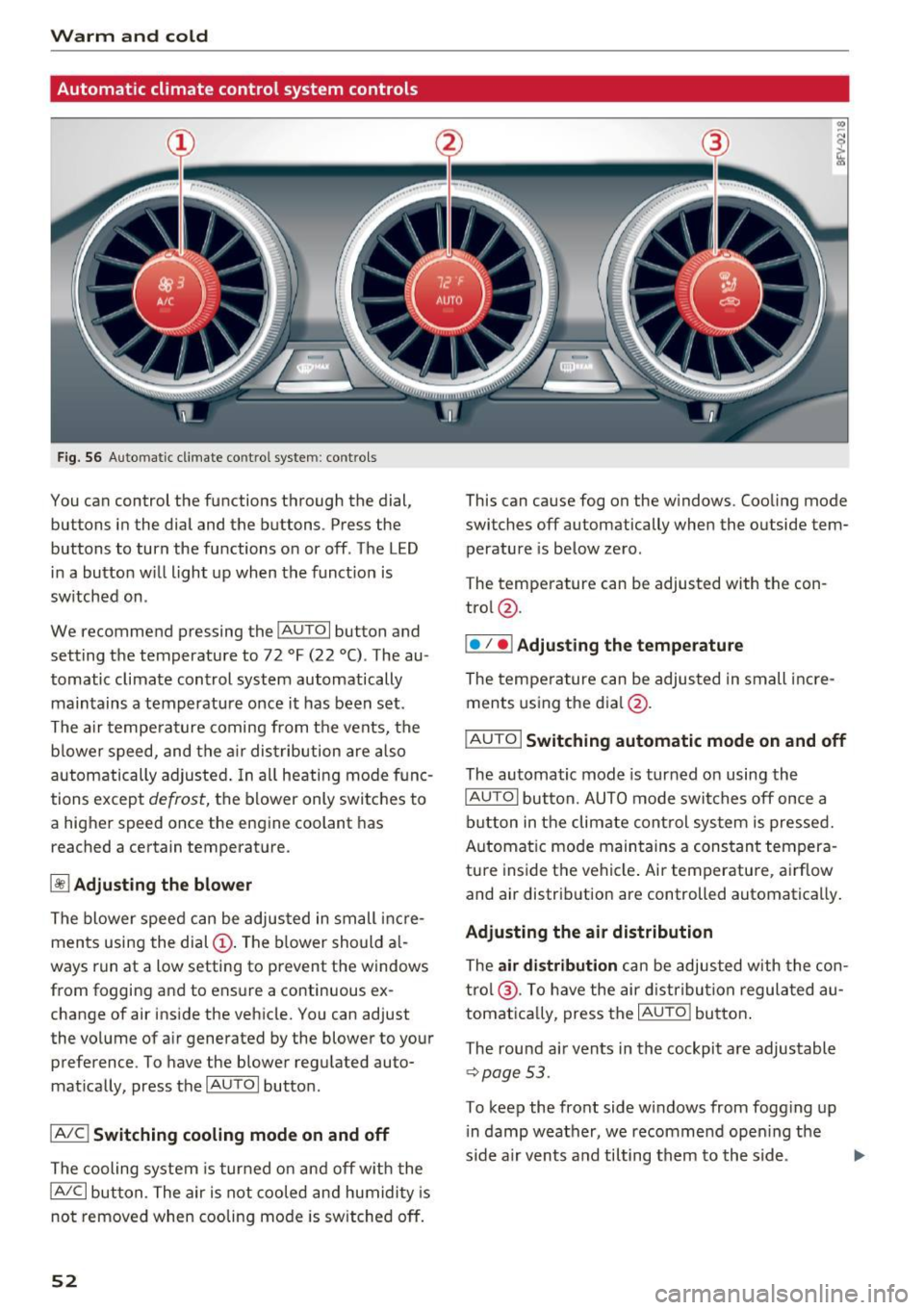
Warm and cold
Automatic climate control system controls
Fig. 56 Automatic climate co ntrol syste m: controls
You can control the functions through the dial,
buttons in the dial and the buttons . Press the
buttons to turn the functions on or off . The LED
i n a button w ill light up when the funct ion is
sw itched on .
We recommend pressing the
IAU TOI button and
setting the temperature to 72 °F (22 °C) . The au
tomatic climate control system automatically
maintains a temperature once it has been set .
The air temperature coming from the vents, the
b lower speed, and the air dis tribution are also
automatically adjuste d. In all heati ng mode func
tions except
defrost, the blower only switches to
a higher speed once the engine coolant has
reached a certain temperat ure.
~ Adjusting the blower
The blower speed can be adjusted in small incre
ments using the dial @. The blower should al
ways run at a low setting to prevent the windows
from fogging and to ensure a continuous ex
change of air inside the vehicle. You can adjust
the volume of a ir generated by the blower to your
preference . To have the blower regulated auto
mat ically, press the
IAUTOI butto n.
IA/C l Switching cooling mode on and off
The cooling system is turned on and off w ith the
IA/C l button. The air is not cooled and humidity is
not removed when cooling mode is switched off.
52
This can cause fog on the w indows. Coo ling mode
switches off automatically when the outside tem
perature is below zero .
The temperature can be adjusted with the con
trol @.
I• I • I Adjusting the tempe rature
The temperature can be adjusted in small incre
ments using the dial@.
I AUTO I Switching automatic mode on and off
The au tomatic mode is turned on using the
IAUTOI button. AUTO mode switches off once a
button in the climate control system is pressed.
Automat ic mode maintains a constant tempera
ture inside the vehicle . Air temperature , airflow
and air distribution are controlled automatically.
Adjusting the air distribution
The air distribution can be adjusted with the con
tro l@ . To have the air distribution regulated au
tomatica lly, press the
IAUTO l button.
The round ai r vents in the cockpit a re adjustable
¢ page 53.
To keep the front side windows from fogg ing up
i n damp weather, we recommend ope ning the
s ide air vents and tilting them to the side.
Page 55 of 322

CD
CD
.... N
" N ...... 0
0
Ill co
1- 1 Switching recirculation mode on and off
The recirculation mode can be turned on manual
l y or automatica lly* .
- Swi tchi ng manual recirculat ion mode on and
off: press
l '-"'> I
- Automa tic* recirculation mode: auto rec ircula
t ion needs to be activa ted in the Infotainmen t
system. Selec t in the Infota inment system :
I MENU I button >Vehicle > left control button
>Vehicle settings> Air conditioning > Auto re
circulation .
The air quality sensor that is de
signed for diese l and gasoline exhaust auto
matically switches the recirculation mode on or
off depend ing on the level of pollutants in the
outside air .
In recircu lation mode, the air inside the vehicle is
circu lated and filtered . This prevents the unfil
tered air outside the vehicle from entering the
vehicle interio r. We recommend switching recir
culation mode on when dr iv ing through a tunnel
or when sitting in traffic
c::> .&,.
Recirculation mode is switched off by pressing
the ~ button or
I AU TO I orl w MAX !.
I@ MAXI Switching defrost on and off
The winds hield and side windows are defrosted
or cleared of condensation as quickly as possible.
The optimum amount of a ir flows main ly out of
the vents under the windshield . Recirculation
mode switches off . The temperature is controlled
automatically .
The
IAUTOI button switches the defroster off.
I @ REAR I Switching the rear window defogger
on and off
If the rear w indow defogger is activated when
the ignition is switched on, the battery manage
ment determines based on the battery charge if
it is possib le to turn on. Otherwise, the rear win
dow defogger functions with the engine running
and switches off automatically after approxi
mately 10 -20 min utes, depending on the out
side temperature.
To prevent t he rear w indow defogger from
switching off automatically, press and hold the
I@ REARI button for more than two seconds. This
Warm and cold
remains stored up to approximately 15 minutes
after t urning off the ignition.
.&_ WARNING
-
You should not use the recirculation mode for
an extended period since no fresh a ir is drawn
in. With the air-conditioning switched off, the
windows can fog up, which increases the risk
of an acc ident .
Adjusting the air vents
Fig. 57 Cock pit: adjust ing the a ir vents
To adjust the direction of air flow, turn the
ridged outer ad justment wheel
(D e::> fig . 57.
To adjust the amount of air flow , move the lever
@ on the a ir vent. To stop the air flow, move the
lever all the way to the left.
Seat heating
Fig. 58 Air vents: seat heat ing
The seat heating has three levels . The se lected
heat leve l is indicated by the LED.
.,. To switch the seat heating on, press the~ but
ton once.
.,. To switch to a lower level, press the~ button
aga in.
IJl,,
53
Page 56 of 322
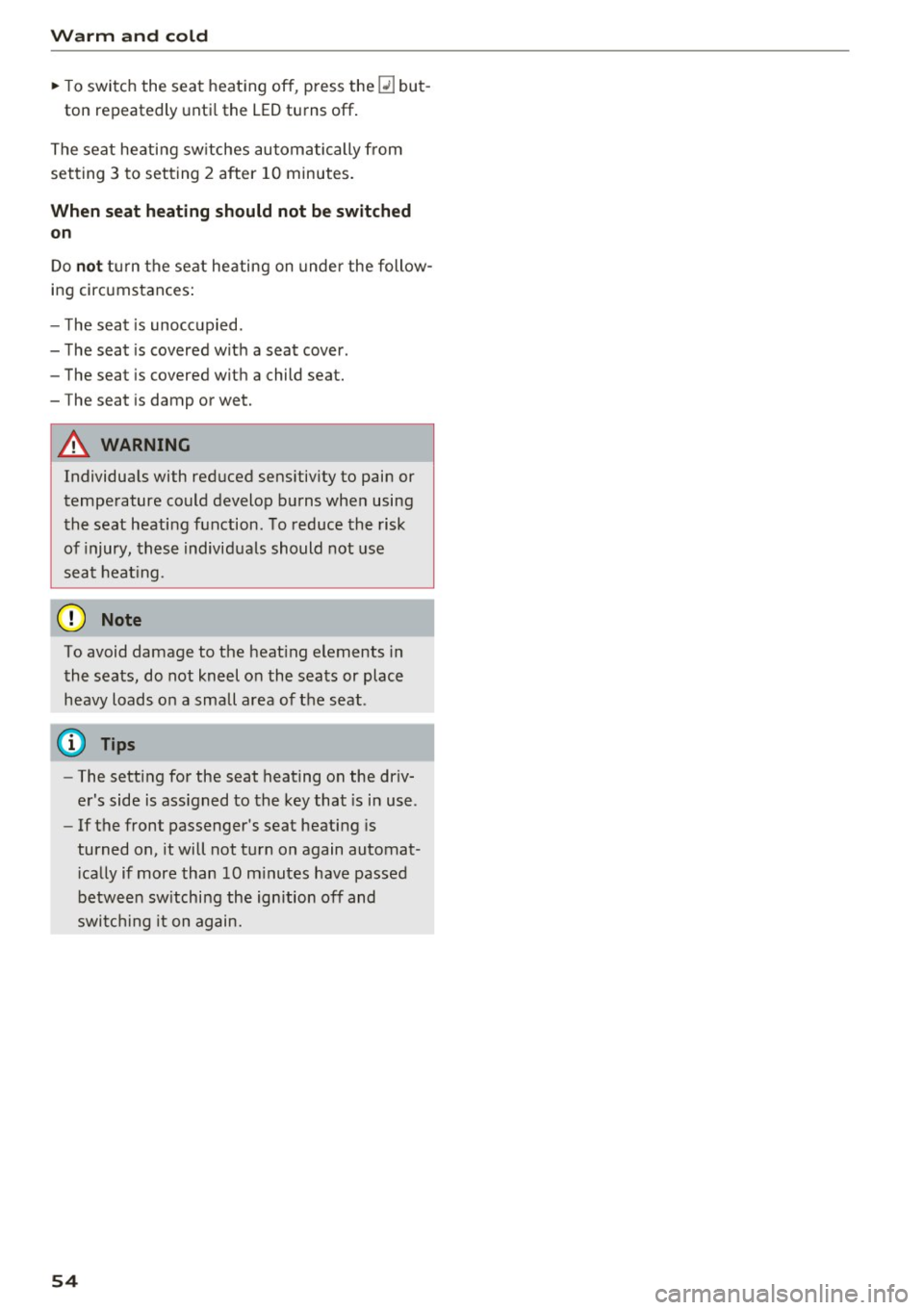
Warm and cold
"'T o switch the seat heating off, press the~ but-
ton repeatedly unti l the LED turns off.
The seat heating sw itches automatically from
setting 3 to setting 2 after 10 minutes.
When seat h eat ing sh ould not be switched
on
Do n ot turn the seat heating on under the follow
ing circumstances:
- T he seat is unoccupied .
- The seat is covered with a seat cover .
- The seat is covered with a child seat.
- The seat is damp or wet.
A WARNING
Individuals with reduced sensitivity to pain or
temperature could develop burns when using
the seat heating function . To reduce the risk
of injury, these individuals should not use
seat heat ing .
(D Note
To avoid damage to the heat ing elements in
the seats, do not kneel on the seats or place
heavy loads on a small area of the seat .
(D Tips
-The setting for the seat heating on the driv
er's side is ass igned to the key that is in use .
- If the front passenger's seat heating is
turned on, it will not turn on again automat
i cally if more than 10 m inutes have passed
between sw itching the ignition off and
switching i t on again.
54
Page 57 of 322
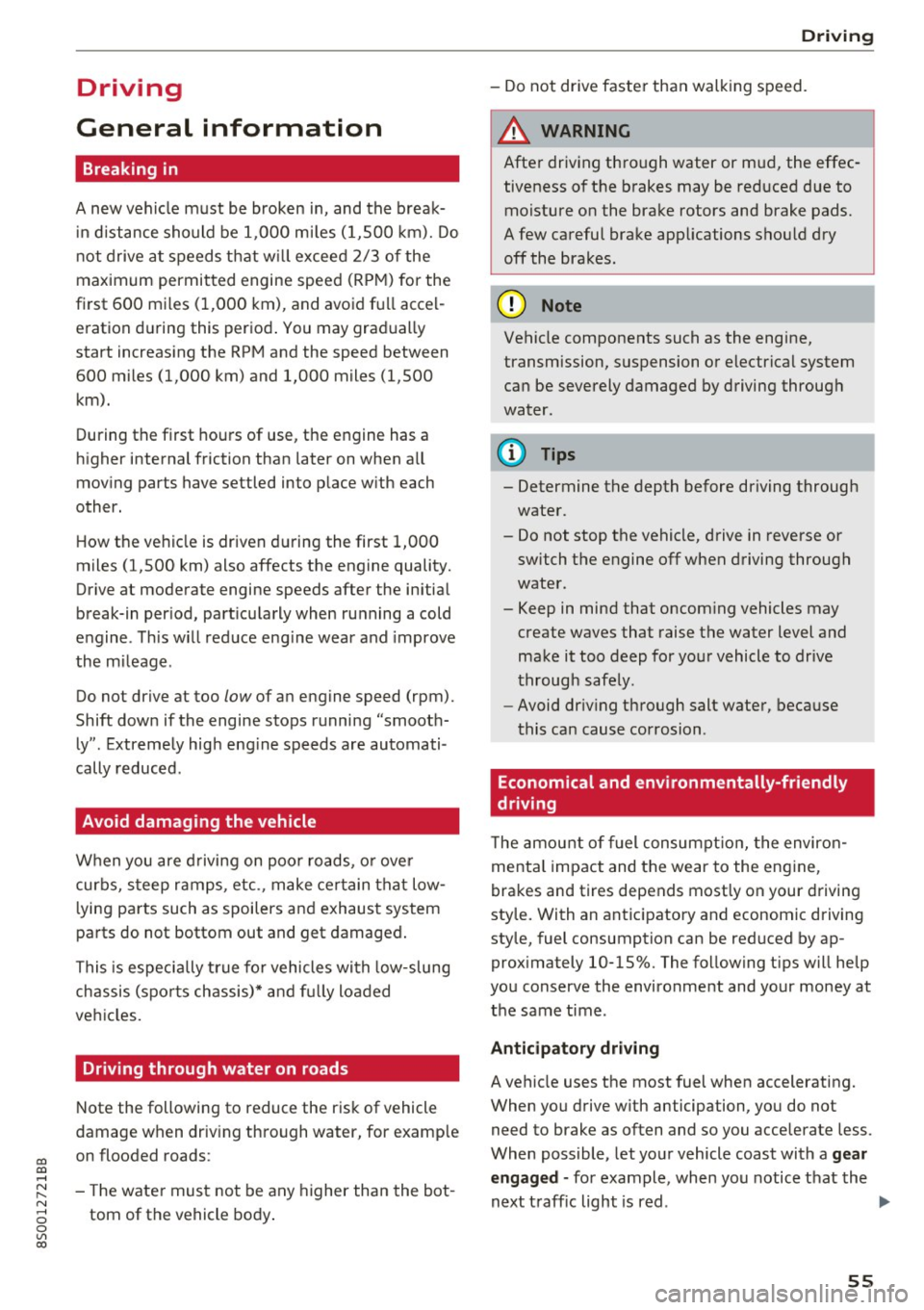
co
co
.... N
" N .... 0
0
Vl c:o
Driving
General information
Breaking in
A new vehicle must be broken in, and the break
in distance should be 1,000 mi les ( 1,500 km). Do
not drive at speeds that w ill exceed
2/3 of the
maximum permitted engine speed
(RPM) for the
first 600 miles (1,000 km) , and avoid full accel
eration during this period . You may gradually
start increasing the
RPM and the speed between
600 miles (1,000 km) and 1,000 miles (1,500
km).
During the first hours of use, the engine has a
higher internal friction than later on when all
moving parts have settled into place with each
other.
How the vehicle is driven during the first 1,000
miles (1,500 km) also affects the engine quality.
Drive at moderate engine speeds after the initial
break-in per iod, part icularly when running a cold
engine . This will reduce engine wear and improve
the mileage .
Do not drive at too low of an engine speed (rpm).
Shift down if the engine stops running "smooth
ly" . Extremely high eng ine speeds are automati
cally reduced .
Avoid damaging the vehicle
When you are driving on poor roads, or over
curbs, steep ramps, etc., make certain that low
lying parts such as spoilers and exhaust system
parts do not bottom out and get damaged.
This is especially true for vehicles with low-slung
chassis (sports chassis)* and fully loaded
vehicles.
Driving through water on roads
Note the following to reduce the risk of vehicle
damage when driving through water, for examp le
on flooded roads :
- The wate r must not be any higher than the bot
tom of the vehicle body .
Driving
- Do not drive faster than walking speed.
A WARNING
After driv ing through water or mud, the effec
tiveness of the brakes may be reduced due to moisture on the brake rotors and brake pads.
A few careful brake applications should dry
off the brakes .
(D Note
Vehicle components such as the engine,
transmission, suspension or electrical system
can be severely damaged by driving through
water.
(D Tips
- Determine the depth before driving through
water.
- Do not stop the vehicle, drive in reverse or
switch the engine off when driving through
water.
- Keep in mind that oncoming vehicles may create waves that raise the water level and
make it too deep for your vehicle to drive
through safely.
- Avoid dr iving through salt water, because
this can cause corrosion.
Economical and environmentally-friendly
driving
T he amount of fuel consumpt ion, the environ
menta l impact and the wear to the engine,
brakes and tires depends mostly on your driving
style. With an anticipatory and economic driving
style, fuel consumption can be reduced by ap
proximately 10-15%. The following tips will help
you conserve the environment and your money at
the same time .
Anticipatory driving
A vehicle uses the most fuel when accelerating.
When you drive with anticipation, you do not
need to brake as often and so you accelerate less.
When possible, let your vehicle coast with a
gear
engaged -
for example, when you notice that the
next traff ic light is red . .,,.
55
Page 58 of 322

Driving
Avoid full acc ele ra tion
You sho uld rare ly travel at the maximum vehicle
speed . High speeds cause a disp roportionately
high increase in fuel consumption, emissions and
traffic noise . Slower driving saves fuel.
Reduce idling time
It pays off to stop the engi ne, for examp le when
at rai lro ad crossings or tr affic lights with longer
red lights . Stopping the engine for 30 -40 sec
onds already saves more fuel than the amount of
extra fuel needed to resta rt the engine.
It t akes a very long time in idle to wa rm the en
g ine up to operating tempe ra ture . Wear and
emissions are especially high in the warm-up
p hase . Therefore, yo u should begin driving im
mediately after starting the engine. Avoid high
RPMs while do ing th is.
Have ma intenanc e performed r egularly
By having maintenance performed regular ly on
your vehicle, yo u can help to reduce f uel con
sumpt ion before you even start to dr ive. The
maintenance condition of your vehicle not only
affects traffic safety and long-term value but a l
so impacts
fuel consumpt ion .
A poorly maintained engine can lead to fuel con
sumpt ion that is 10% higher than normal.
A lso check the
oil le vel when refueling . The o il
consumption
depends large ly on the engine load
and speed. It is normal for the oil consumpt ion
of a new eng ine to reach its lowest point only af
ter a certain amount of use. Therefore, the oil
consumption can o nly be properly judged after
approx imately 3,000 m i (S,000 km) have been
d riven.
Avoid short trips
The engine and exhaust cleaning system must
reach the ir opt imal
operating temperature to ef
fectively red uce consumption and em iss ions.
A co ld engine uses a disproportionately h igh
amount of fuel. The engine reaches operating
temperature and consumpt io n normalizes only
afte r approximately
four kilometers.
56
(D Note
Do not leave engine idling unattended after
starting. If warning lights sho uld come on to
i ndicate imprope r operation, they would go
unheeded. Extended idling also produces
h eat, which could result in overheating or
other damage to the vehicle o r other proper
ty.
(D Note
- Have your ve hicle ma intained properly and
in accordance with the service recommenda
t ions i n your Warranty
& M aintenance book
let. La ck of prope r mai nte na nce as we ll as
imp roper use o f the ve hicle will impa ir the
func tion of the emission cont ro l sys tem and
cou ld lead to damage.
- Do not alte r or remove any compone nt of
the Emission Contro l System unless ap
proved by the man ufacturer.
- Do not alte r or remove any dev ice, such as
heat shields, switches, ig nition w ires,
valves, which are designed to protect your
vehicle's Emission Contro l System and other
important veh icle components.
(D Tips
The cons umption estimates as publishe d by
ENVIRONMENTAL PROTECTION AGENCY
(EPA) and Transport Canada may not corre
spond to your actual consumption on the r oad, which wi ll vary depending upon vehicle
l oad and speed, road a nd wea ther conditions,
tr ip length, etc.
Page 59 of 322
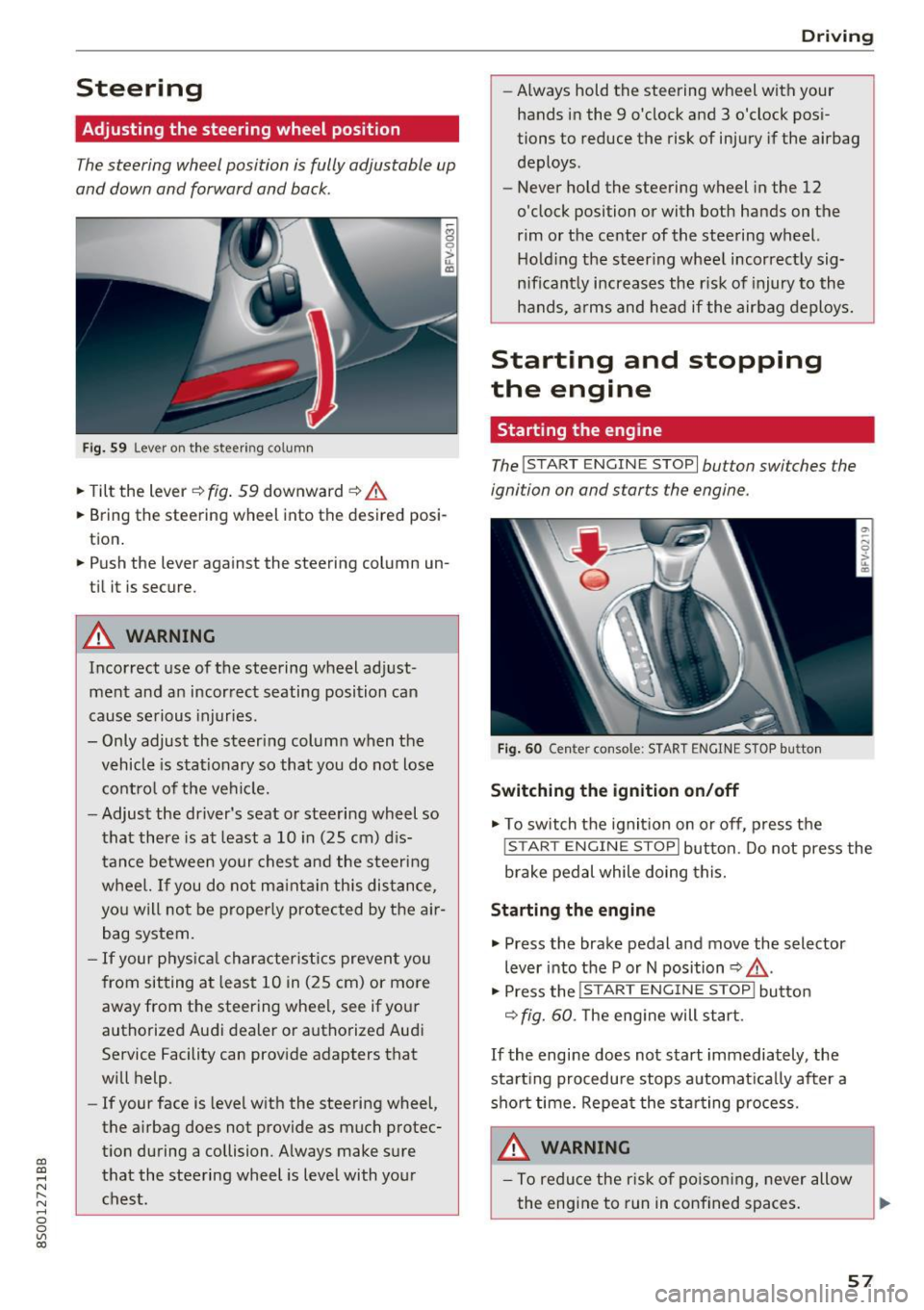
CD
CD
.... N
" N ...... 0
0
Ill co
Steering
Adjusting the steering wheel position
The steering wheel position is fully adjustable up
and down and forward and back.
Fi g. 59 Lever on th e steering column
... Tilt the lever c:::> fig . 59 downward c:::> A
... Bring the steering wheel into the desired posi
tion .
... Push the lever against the steering column un
t il it is secure.
A WARNING
Incorrect use of the steering wheel ad just
ment and an incor rect seating posi tion ca n
cause se rious injuries.
- Only adjust the steeri ng column when the
vehicle is stat ionary so that you do not lose
cont ro l of the ve hicl e.
- Adjus t the dr iver's seat or steering wheel so
that there is at least a 10 in (25 cm) d is
t an ce betwee n your chest a nd t he s teering
w heel. If y ou d o not m aint ain this dis tan ce,
yo u will n ot be proper ly protected by the a ir
bag system.
- If your phys ic al characteris tics p reven t you
from sit ting a t least 1 0 in ( 25 cm) or mo re
away from the steering whee l, see if yo ur
authorized Audi dea ler or autho rized Audi
Service Facility can prov ide adapters that
will help.
- If your face is leve l with the steering wheel,
the a irbag does not provide as much protec
t io n during a collision. Always make s ure
tha t the steering wheel is leve l with yo ur
chest.
D rivi ng
-Always hold the steering wheel with your
hands i n the 9 o'clock and 3 o'clock pos i
tions to reduce the risk of injury if the airbag
deploys.
- Never hold the steering wheel in the 12
o'clock position or with both hands on the
rim or the center of the stee ring wheel.
H old ing the steer ing whee l incorrect ly sig
n ificant ly increases the r isk of injury to the
hands, a rms and head if the air bag deploys.
Starting and stopping
the engine
Starting the engine
The ! S TART ENGINE STOPI button switches the
ignition on and starts the engine .
Fig . 60 Center console: START ENGINE STOP b utto n
Switching the ignition on /off
... To switch t he ignit io n on or off, press t he
!START ENGI NE STOPI but ton. Do not press the
brake pedal while doing this.
Starting the engine
... Press the brake pedal a nd move the selector
lever into the P or N position
c:::> ,&. .
... Press the !START ENGINE STOP I butto n
<=:> fig. 60. The eng ine will start.
If the engine does not start immediately, the
sta rt ing procedure stops a utoma tica lly after a
sho rt time. Repea t the s ta rt ing process .
A WARNING
- To redu ce the r is k of p oisoni ng, never allow
the eng ine to run in confined spaces.
57
Page 60 of 322
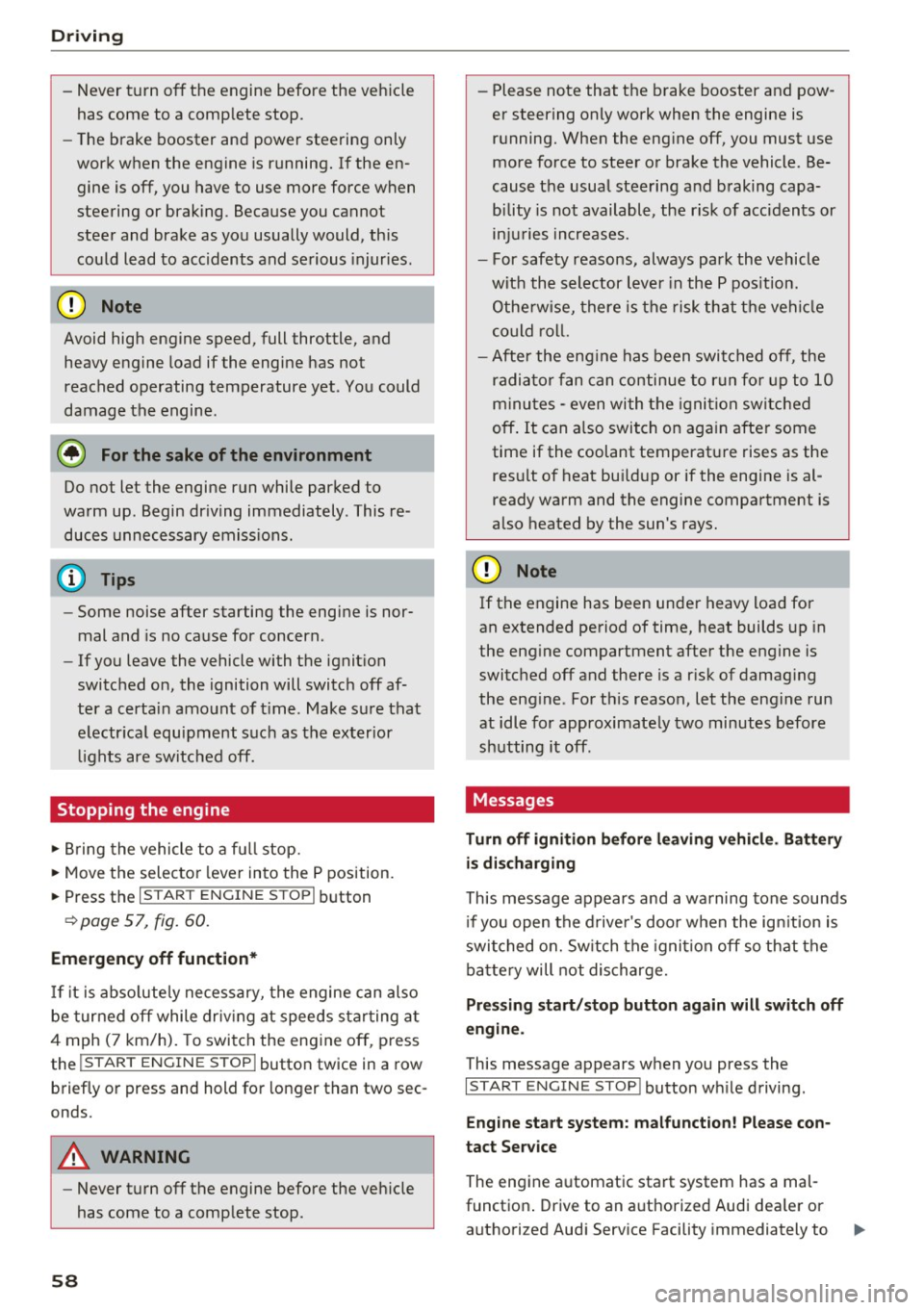
Driving
-Never turn off the engine before the vehicle
has come to a complete stop.
- The brake booster and power steering only
work when the engine is running. If the en
gine is
off, you have to use more force when
steering or braking. Because you cannot
steer and brake as you usually would, this
could lead to accidents and serious injuries.
(D Note
Avoid high engine speed, full throttle, and
heavy engine load if the engine has not
reached operating temperature yet. You could
damage the engine.
@ For the sake of the environment
Do not let the engine run while parked to
warm up. Begin driving immediately . This re
duces unnecessary emissions.
{D) Tips
-Some noise after starting the engine is nor
mal and is no cause for concern.
- If you leave the vehicle with the ignition
switched on, the ignition will switch
off af
ter a certain amount of time . Make sure that
electrical equipment such as the exterior
lights are switched
off.
Stopping the engine
.,. Bring the vehicle to a full stop.
.,. Move the selector lever into the P position .
... Press the
I START ENGINE STOPI button
¢ page 57, fig. 60.
Emergency off function*
If it is absolutely necessary, the engine can also
be turned
off while driving at speeds starting at
4 mph (7 km/h). To switch the engine
off, press
the
! START ENGINE STOPI button twice in a row
briefly or press and hold for longer than two sec
onds.
_&. WARNING
- Never turn off the engine before the vehicle
has come to a complete stop.
58
- Please note that the brake booster and pow
er steering only work when the engine is
running. When the engine
off, you must use
more force to steer or brake the vehicle. Be
cause the usual steering and braking capa
bility is not available, the risk of accidents or
. . . . mJunes increases.
- For safety reasons, always park the vehicle
with the selector lever in the P position.
Otherwise, there is the risk that the vehicle
could roll.
- After the engine has been switched off, the
radiator fan can continue to run for up to 10
minutes -even with the ignition switched
off. It can also switch on again after some
time if the coolant temperature rises as the
result of heat buildup or if the engine is al
ready warm and the engine compartment is
also heated by the sun's rays.
(D Note
If the engine has been under heavy load for
an extended period of time, heat builds up in
the engine compartment after th@ engine is
switched
off and there is a risk of damaging
the engine . For this reason, let the engine run
at idle for approximately two minutes before
shutting it
off.
Messages
Turn off ignition before leaving vehicle. Battery
is discharging
This message appears and a warning tone sounds
if you open the driver's door when the ignition is
switched on. Switch the ignition
off so that the
battery will not discharge.
Pressing start/stop button again will switch off
engine.
This message appears when you press the
I START ENGIN E STOP ! button while driving.
Engine start system: malfunction! Please con
tact Service
The engine automatic start system has a mal
function. Drive to an authorized Audi dealer or
autho rized Audi Service Facility immediately to
IJlo-